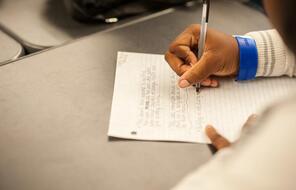
The Meaning of Home
Duration
One 50-min class periodSubject
- English & Language Arts
Grade
11–12Language
English — USPublished
Updated
Get it in Google Drive!
Get everything you need including content from this page
Get it in Google Drive!
Get everything you need including content from this page
Overview
About This Lesson
Although most students will have an idea of what “home” means, they may be less familiar with the concept of home as both a physical location and psychological phenomenon. In his work on belonging, social psychologist Geoffrey Cohen defines home as “a psychological experience—not just a place.” 1 Similarly, scholar Wilfred M. McClay posits that a person’s sense of home contributes significantly to their sense of self and belonging. These considerations become increasingly important for older adolescents as they approach adulthood and renegotiate their relationship with the home(s) they have known as children. While juniors and seniors are likely to field questions like, “What will you do after you graduate?” or “Where do you plan to go after high school?” it seems just as important, if not more, to contemplate, “Who are you? Where did you come from? Where is your home? Where do you fit in the order of things?” 2
With these ideas in mind, this lesson introduces concepts that students will explore throughout the text set. As they engage with a variety of quotations, reflect on their own understanding of home, and listen to a TED Talk, students will have the opportunity to connect their experiences and prior knowledge to the essential and guiding questions of this unit.
Lesson Materials
- Handout: Exploring “Home” through Notable Quotes
- Teacher Handout: Reimagining Home: Gallery Walk Quotations
- Video: TED Talk: “Where Is Home?” by Pico Iyer
- Handout: ”Where Is Home?” Viewing and Reflection Guide
Essential Questions
-
How can reimagining “home” empower us to define how and where we belong in the world?
Guiding Questions
- How can we imagine home beyond its traditional definition of a place where one lives?
- How might the memories of our experiences contribute to a sense of home?
Facing History Learning Outcomes
- Analyze the author’s representation of individual and collective agency in the text and compare and contrast it to their own beliefs and experiences in the world.
Lesson Plans
Activities
Unlimited Access to Learning. More Added Every Month.
Facing History & Ourselves is designed for educators who want to help students explore identity, think critically, grow emotionally, act ethically, and participate in civic life. It’s hard work, so we’ve developed some go-to professional learning opportunities to help you along the way.
Exploring ELA Text Selection with Julia Torres
On-Demand

Working for Justice, Equity and Civic Agency in Our Schools: A Conversation with Clint Smith
On-Demand

Centering Student Voices to Build Community and Agency
On-Demand














